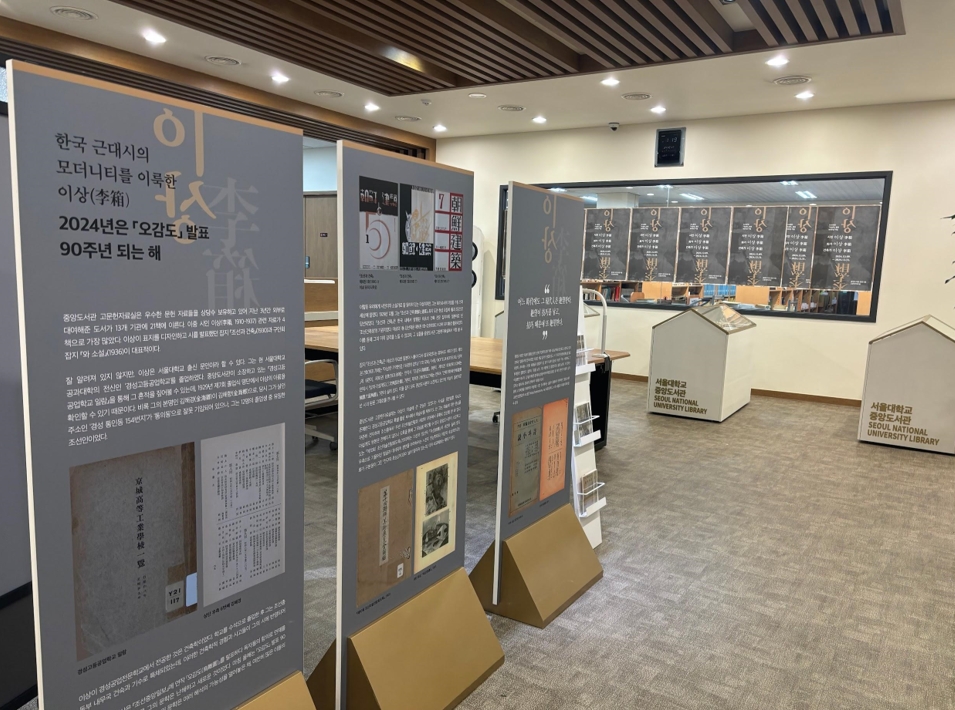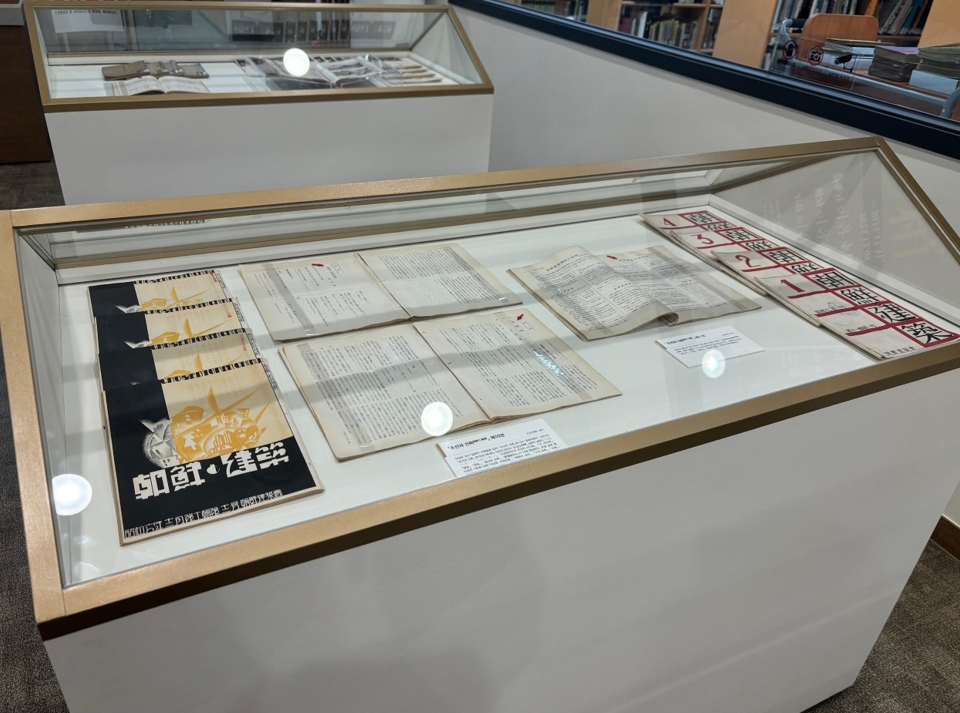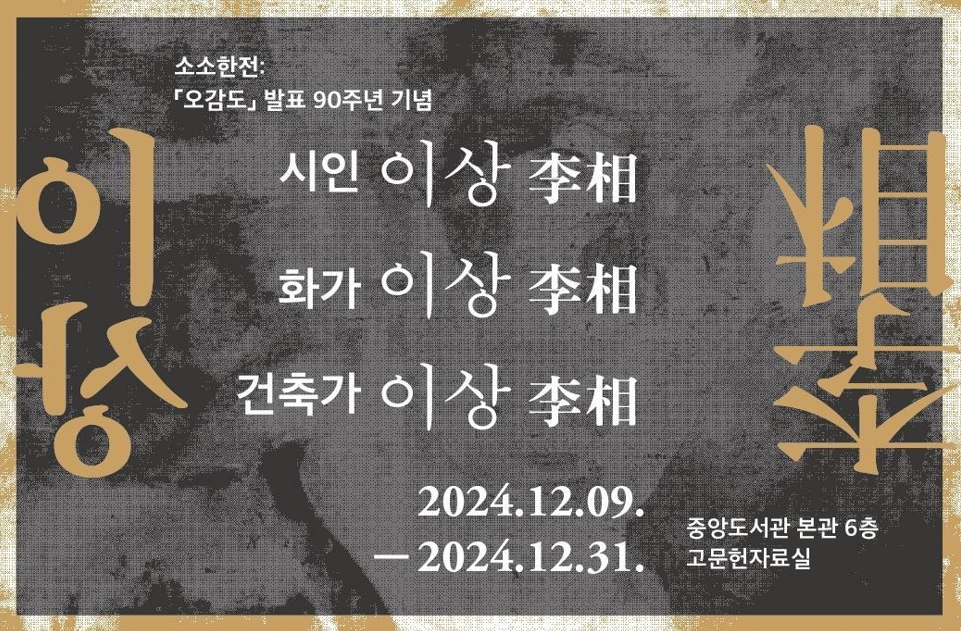From December 9 to 31, the SNU Library hosted an exhibition in celebration of the 90th anniversary of Yi Sang’s poetry series Crow’s Eye View. Having taken place in the library’s Rare and Old Books Collection, the exhibition displayed Yi Sang's early works, including his Japanese-language poems, paintings, and the Joseon and Architecture magazines that used his cover designs. It also included the Kyungsung Institute of Engineering Yearbook, which provides a glimpse into his high school years.

Photograph of the exhibition
Venturing into Yi Sang’s Early Days
While Yi Sang is widely celebrated as a poet and novelist, few people know that he studied at the predecessor of Seoul National University. Yi Sang completed his studies at Kyungsung Institute of Engineering, the predecessor of SNU's College of Engineering, where he graduated in 1929 as the sole Korean among the 12 graduates that year. The 1929 Kyungsung Institute of Engineering Yearbook is also the first known use of his art name as he was previously known by his birth name Kim Haegyŏng. At Kyungsung Institute of Engineering, Yi Sang majored in architecture. Graduating as valedictorian, he was specially appointed as a public official in the architecture team of the Department of Domestic Affairs of the Government-General of Korea.
In 1934, he published the series Crow’s Eye View in the Joseon Joongang Ilbo. This year marks the 90th anniversary of the publication of Crow’s Eye View, which is still receiving many different interpretations, a testament to Yi Sang’s enduring influence in modern Korean literature.
Yi Sang: A Painter Before a Poet

Joseon and Architecture 10th volume (1931)
Yi Sang first gained recognition not as a poet but as an artist. In December 1929, he won first and third place in a cover design competition for Joseon and Architecture. This magazine was published by the Korean Architecture Society and was the first architecture-focused journal published in Korea. It utilized Yi Sang’s winning design for all 12 issues of its ninth volume published in 1930, which can be viewed at the Rare and Old Books Collection.
The magazine also featured many of Yi Sang’s early Japanese-language poems, such as A Strange Reversible Reaction, a set of seven poems under the name Three-Dimensional Angle Blueprint, and a series of seven poems under the name Building Infinite Hexahedral Bodies. These original texts in Japanese remain preserved in their entirety at the Central Library.
Apart from his interest in architecture, Yi Sang also had a passion for the visual arts. While at Kyungsung Institute of Engineering, he joined the art club and maintained a keen interest in painting. Notably, he exhibited an oil painting, titled Portrait, at the Government-General’s Joseon Art Exhibition and received an honorable mention. Although the original painting has been lost, its likeness is preserved in the 10th Joseon Art Exhibition Catalog, housed in the Rare and Old Books Collection. Portrait features a face tilted slightly to one side with a piercing gaze directed at the viewer.
Yi Sang and the Guinhoe

Poster for the exhibition
The Central Library also houses the first issue of Poetry and Novels, the magazine of the literary group Guinhoe, in which Yi Sang was active. After joining Changmun Publishing in 1935, Yi Sang edited the magazine and contributed the poem Street Exterior, Street Passage. In the preface of this first issue, the Guinhoe members each left short notes, with Yi Sang writing “Every era leaves its contemporaries in despair. Despair breeds technique, and technique breeds further despair.”
This magazine also features works by other prominent writers, marking its importance in the history of Korean literature. While this magazine is currently undergoing restoration and unavailable for display, its contents can be accessed online through the Central Library’s Rare Book Archive System.
Yi Sang’s contributions as a poet, novelist, artist, and editor demonstrate his multidimensional talent and his lasting impact on Korean art and literature. The Central Library’s Rare and Old Books Collection offers an unparalleled opportunity to explore these facets of his legacy firsthand.
Written by Eusun Lee, SNU English Editor, sunnylee006@snu.ac.kr

